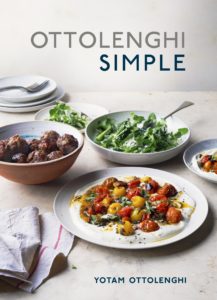Israeli celebrity chef Yotam Ottolenghi is a London-based restaurateur and cookbook author. Many people credit him with elevating the status of Israeli food and triggering worldwide interest in the fare.
Yet Ottolenghi downplayed his role in sparking the Israeli food trend when he visited Toronto earlier this month to promote his new book, Ottolenghi Simple.
“I did not single-handedly make Israeli food popular,” he said in a telephone interview. “My food is a big mixture of many things. I have never been predominantly Israeli.”
He said that through his extensive travels, he’s been inspired to expand the scope of his culinary repertoire to include foods and spices from other places, like India and East Asia.
But he does acknowledge his role in disseminating Middle Eastern recipes.
“A lot of people got exposed to my Middle Eastern dishes from Jerusalem, the book Sami (Tamimi) and I wrote.
“These were the dishes we ate growing up. We modernized them. For many people, this was their first encounter with Israeli food.”
Ottolenghi said his family is of mixed European heritage. “My father’s roots are northern Italian. He made these great Italian sauces and pasta and polenta. My mother comes from a German background. Her food was more Ashkenazi,” he said.
“My parents were also adventurous eaters. My father was a professor, so we travelled a lot and wherever we went, we would try the food.”
But he traces the early culinary influences on his cooking to the Sephardic and Yemenite street foods he ate as a youngster. “When I was growing up in the ‘70s and ‘80s, the food in Israeli restaurants wasn’t that good, but you could get really great street food,” he said.
“Israeli food has been influenced by all these different groups. In the Old City of Jerusalem, we could get fantastic Palestinian food and the Yemenite food was so delicious. There were so many different ways to cook eggplant.”
Ottolenghi is known for incorporating a wide range of ingredients into his recipes. His new book, Ottolenghi Simple, may therefore sound like an oxymoron, given his penchant for complex dishes.

In fact, in the introduction, he writes, “Ottolenghi Simple is not a contradiction in terms. I know. I’ve seen the raised eyebrows.”
On the phone, he pointed out that “SIMPLE” is actually an acronym. “We created a system with symbols. Not everybody cooks the same way,” said Ottolenghi.
For instance, “S” is actually the icon that stands for recipes you can make if you are short on time, while the “I” applies to recipes with 10 ingredients or less.
“M” is for make-ahead dishes, “P” is for those one can make from pantry ingredients and “L” is for lazy. “Lazy is for stews and for things you can cook in one pot,” he said.
“E” is for easier than you think. “Psychologically, people think they can’t make ice cream. They think it’s too complicated. The ideas are demystified in my recipe for raspberry ice cream,” explained Ottolenghi.
“It’s easy to make raspberry ice cream that’s as good as raspberry ice cream from an ice cream shop.”
Every recipe in the book is colour-coded and has at least one of the letters in “SIMPLE.”
The book includes a lot of the spices used by the various immigrant groups who settled in Israel and influenced its many Middle Eastern dishes.
He said he often flavours his dishes with za’atar, a popular Middle Eastern spice mix comprised of sumac, sesame seeds and the leaves of the za’atar plant, which is native to the Middle East. “Authentic za’atar is easy to get in Israel. You don’t want the za’atar with thyme. It’s not the same,” he advised.
Ottolenghi also uses preserved lemon in several recipes. “At one time, people had to preserve lemons with salt. It’s absolutely delicious when the oil of the (lemon) skin mixes with the salt in the juice. It’s very effective when you add it to stews and salads,” he said.
“The salt and the acidity come together. The lemon skin deepens the flavour of the oil. I use it in the beet salad recipe.”
READ: RECIPES FROM OTTOLENGHI’S BOOK, SIMPLE
When asked about the popularity of Ashkenazic dishes in the hierarchy of Israeli cuisine, Ottolenghi laughed and said that Darwinian theory – i.e., survival of the fittest – applies to Israeli food:
“When all the cultural groups came together (in Israel), each group brought their own food. There was Polish food in one house, Iraqi food and Moroccan food in other houses.… Over the years, the best dishes survived. With Ashkenazi food, it was definitely the baking – the yeasted cakes, the babkas and the rugelach.”






